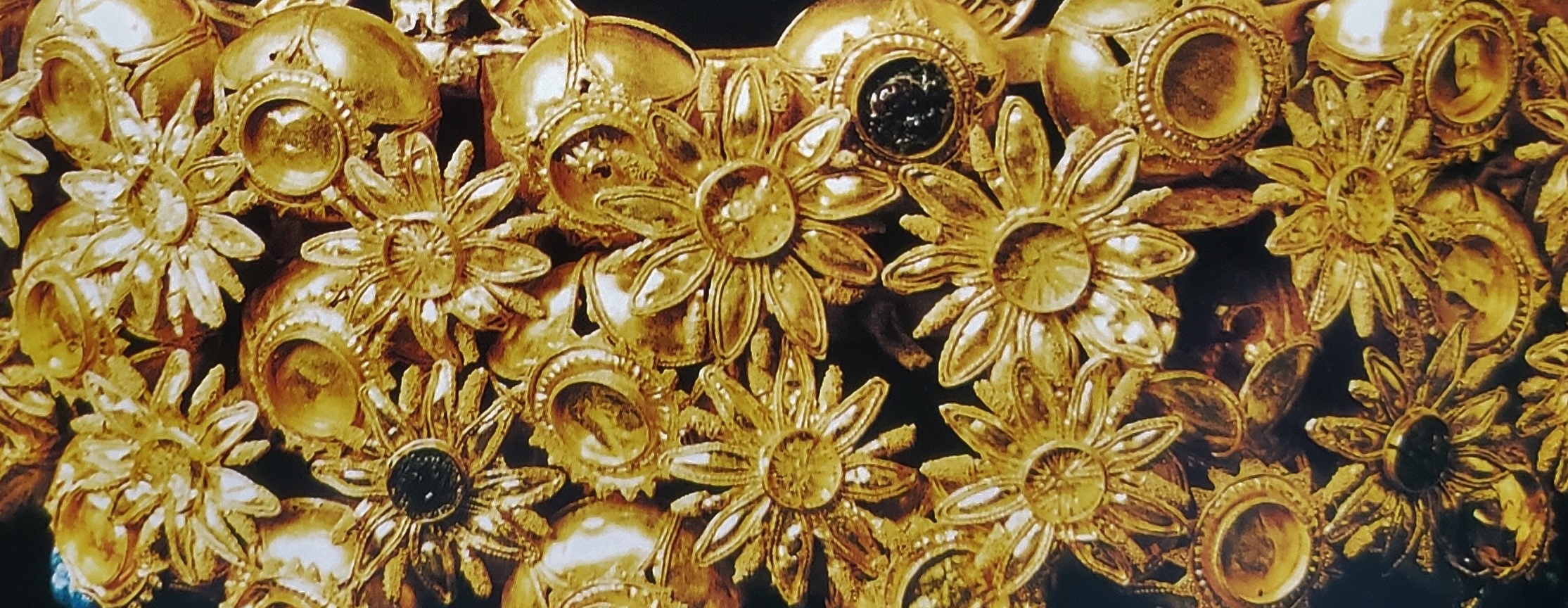Fantastic Jewellery from Nimrud
By Amir Harrak, Professor, Department of Near and Middle East Civilizations, University of Toronto.
September 2020
The Assyrian Capital Kalhu (Nimrud)
Nimrud is the modern name of Kalḫu, one of the Assyrian capital cities located on the bank of the Tigris, near its confluence with the Upper Zab River. King Ashurnasirpal II (ruled between 883 and 859 BC), rebuilt the site as his capital, in which he erected his palace, which he adorned with decorated farsh-stone known in the region of Mosul to this day. The site was excavated in the past century by Max Mallowan, the husband of Agatha Christie, a known novelist. Some of the exhumed winged bulls once decorated the gates of his palace, and stone slabs inscribed in cuneiform, which tell royal exploits and religious beliefs, protected in the distant past the lower sections of walls from water and humidity. It is disheartening that, a few years ago, members of the Islamic State chiselled these winged bulls and destroyed, with frenzy, the exhumed palace, built at least fifteen centuries before Islam.
The Assyrians buried their queens and other state officials under the rooms of the palace, while kings were buried in temples and some in the religious capital Ashur, situated on the west bank of the Tigris River, halfway between Mosul and Baghdad. Most graves were looted in antiquity, as they contained jewelry and precious stones coveted by ancient looters, but some graves escaped violence and destruction. The recently uncovered jewelry in hitherto untouched graves far surpasses in beauty and manufacture the famous treasure of Tutankhamun; moreover, modern machines cannot even emulate their shapes, as we will see.
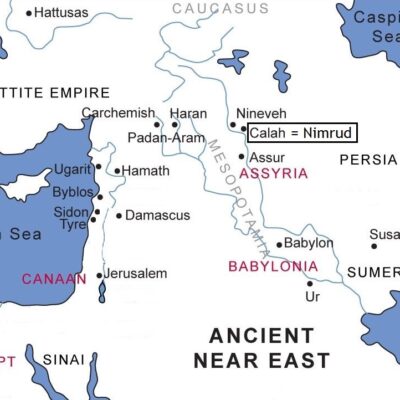
Location of Nimrud and Assur

Nimrud

Plan of Northwest Palace indicating Grave 1,2 and 3
Assyrian Queens Yaba, Baniti and Atalia
In 1989 Iraqi archaeologists noticed protruding bricks in one of the rooms in the north-west palace of Ashurnasirpal II, which proved to be the vault of an underground room, named in modern records Grave 1. This room was built entirely of baked bricks, some of which bear the name of Ashurnasirpal II, but these inscribed bricks were in fact reused to build the room of Grave 1. A baked clay, bath-shaped coffin was found inside the room, containing the undisturbed remains of a woman 50 to 55 years of age. She was buried with an impressive number of jewellery, including a necklace with pomegranate-shaped pendants, earrings with bell-shaped flowers, and seals.
In the same year, the archaeologists uncovered another vaulted tomb, which they called Grave 2. A woman, 30 to 35 years old, was laid down, and we are lucky to know her name thanks to a cuneiform inscription which was placed inside a niche: Ia-ba-a, with whom “mortal destiny caught up, by the command of (the Sun-god) Shamash, Ereshkigal (the queen of the netherworld), and the Anunnaki, the great gods of the netherworld (…); she went the way of her ancestors.” The inscription warns anyone, queen or royal concubine, not to remove any of the tomb’s contents, warning known in other ancient tombs. Yaba’s title was MUNUSÉ.GAL, Akkadian sekallu and biblical segal. The name literally means “Lady of the Palace,” normally referring to a queen.
Yaba was buried inside a coffin covered with three slabs of greyish Mosul marble, unlike the baked clay coffin of Grave l. Her name is not familiar in Assyrian, and since Assyrian kings married, for diplomatic reasons, queens and princesses of various linguistic backgrounds, Yaba may have been one of them. Her importance is reflected in the kind of jewellery that was buried with her. A small gold bowl bears an inscription stating: “Belonging to queen Yaba, wife of Tiglath-pileser, king of Assyria,” a king who ruled between 745 and 727 BC. Other bowls bear similar inscriptions, one of which mentions Baniti, queen of Shalmaneser (V), who ruled between 727 and 722 BC, and a third one mentioning Atalia, queen of Sargon (II), who reigned between 722 and 705 BC. Thus, these kings succeeded one another between 745 and 705 BC, inaugurating the greatest, and last, period of Assyria’s history.
In the same year, Grave 3 was uncovered inside which there were three coffins in its front room, in which some 13 persons were buried, judging by the bone remains. It seems that they were buried elsewhere but their remains were transferred to this collective grave. The buried ones include a woman aged between 20 and 29 years, and many children aged between 3 months and 11 years. The young woman is described as having exceptionally elegant feet, and the fact that she was buried with many children suggests that they had succumbed together in a long-ago mortal tragedy. One of the coffins contains the bones of five adults, three women and two men, one of the two could be a military general whose name is inscribed in one of the vessels.
Research on the Nimrud Jewellery
The first illustrated article on the Jewellery of Nimrud was published by Time, on Monday, Oct. 30, 1989: “The Golden Treasures of Nimrud: An Assyrian Fortress City Yields Archaeological Prizes of Rare Delight,” written by Philip Elmer-Dewitt.
In 1990 the Canadian Society for Mesopotamian Studies (CSMS) invited me to give a lecture on the Nimrud jewellery, a lecture that was published in the Bulletin of the CSMS of the same year. Between 1996 and 1999, while I was working on Syriac Epigraphy at the Iraq Museum in Baghdad, I saw some of the Nimrud jewellery exhibited there where I could examine them and photographs them.
Since 1990, several publications appeared on this jewellery, the two most important of them are 1) M. S. Damerji and Ahmed Kamil, Gräber Assyrischer Königinnen aus Nimrud (Mainz, 199); this German-Arabic book contains the first detailed reports on the excavations, along with excellent pictures of the jewellery—nearly all the pictures of the current article are taken from this admirable book; 2) J. E. Curtis, H. McCall, D. Collon and L. al-Gailani Werr (editors), New Light on Nimrud: Proceedings of the Nimrud Conference 11th–13th March 2002 (London: British Institute for the Study of Iraq in association with The British Museum, 2008); this scholarly publication also relied on Damerji-Kamil’s monograph for the pictures.
Jewelleries of Immense Beauty
The graves of Assyrian queens provided a great number of jewels that were subjected, after discovery, to several scholarly studies (see the bibliography at the end). Some jewels were displayed on the body, including headdresses, bracelets, bangles, and earrings, and indeed these were found by archaeologists attached to bones of what remained from deceased queens. Other jewels are vessels, all made of pure gold, including dishes, jugs, and bottles. Rather than classifying these objects according to the graves in which they were found, they are listed here according to their types, whether personal jewellery or vessels, although the graves from which they derived are noticed.
Jewelleries
Assyrian queen wore impressive jewelleries, mostly made in Assyria, judging from the artistic motifs, including local fruits and religious themes. Interestingly, they were buried adorned with these jewels, possibly so as to look attractive to the deities of the netherworld.
Necklaces
A necklace from Grave 1 (figure 3) is made of gold beads and hanging pomegranates. There are also three isolated pomegranates that possibly belonged to another necklace; the largest pomegranate has more than seven angular sepal spikes. The fruit is produced in Upper Mesopotamia even today, and its nice shape was exploited by goldsmiths through the ages to create necklaces and pendants. In ancient Assyria, gold pomegranate-shaped pendants were found in the religious capital Ashur (modern Shirqat), in a 13th century BC grave. Also an Assyrian relief found in Nineveh shows a man holding three long branches of pomegranates, behind another man holding branches of another type of flowers or fruits (Layard, Nineveh and Babylon, p. 339).
One of the most fascinating items of the jewellery collection from Grave 2 is the gold necklace with a clasp of entwined dragons’ heads (Figure 1). The string is formed by a golden tube incised with alternating vertical and horizontal wavy lines. Suspended around the tube, by a wire passing through rings soldered on the top of each pendant, are 28 golden, almond-shaped pendants. The goldsmith exploited an ancient Mesopotamian theme, the entwined dragons’ heads, to fashion the hook of the necklace.
Three more necklaces derive from Grave 2 (figure 2). Item A is made of a golden tube partitioned into small square shapes, and a string to which almond-shaped pendants made of semi-precious stones are attached. Originally, 20 pendants were placed but 19 of them survived. The necklace is elegant, finely made, and masterfully fabricated. Item 2 is made of various types of beads, and C is a combination of beads and woven gold.
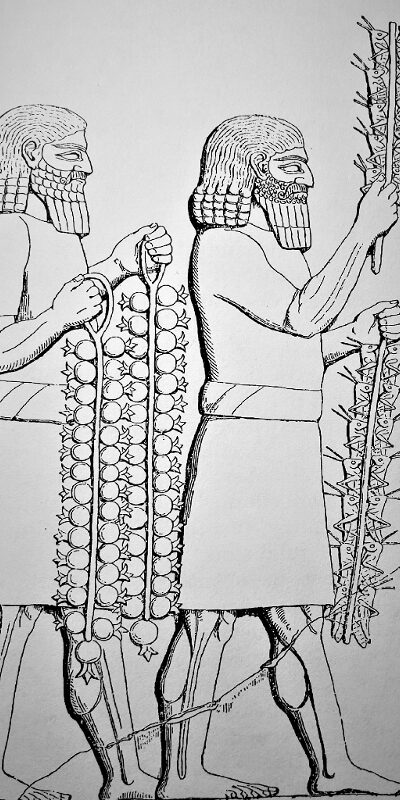
Assyrian relief
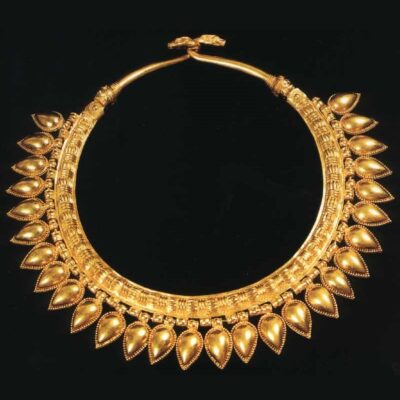
Fig (1)

Fig (2)
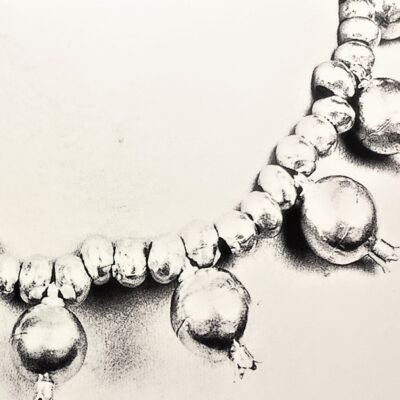
Fig (3)
Bracelets
A pair of bracelets (Figure 4) made of gold and precious stones were among the treasures of Grave 1. Each bracelet is decorated on the outside with thin panels on the top and on the bottom, in addition to the portioned large space between the panels. This middle part is made of ribs of gold and squares spaces filled with precious stones. Bracelets are the most popular jewelry item in ancient art, placed around the wrists and around the arms.
A pair of one-inch-wide solid gold bracelets had tripartite loops ending in abutting lions’ heads (figure 5). The motif of the lion’s head was very popular in the ancient Near East, both in jewellery and other tools, such as handles of clubs and vessels. The workmanship of our bracelets is of unmatchable finesse, even when compared to the remarkable bracelets previously found at other sites, such as Ziwiye in Iran. The Assyrian bracelets are one century earlier than the former jewellery. Bracelets must have been the favourite jewellery of Assyrian men and women, judging from the Assyrian reliefs on which they have been frequently depicted.

Fig (4)

Fig (5)
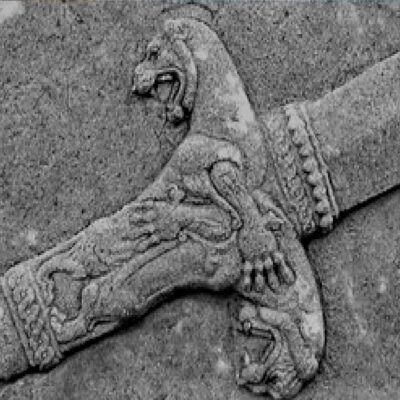
Assyrian relief
Earrings
Grave 1 provided at least two pairs of earrings (figure 6), one of which (A) made of several conical bells in ascending pattern, a flower that must have been part of the natural scenery in ancient Assyria. The bells are attached to short chains by means of rings, soldered from the narrow sides of the flowers. No parallels of such earrings are found in Assyrian art nor in the repertoire of the ancient Near East, so we are fortunate to have this kind of jewellery. The second earrings (B) is made of a crescent-shaped base with a thin wire extended from it meant to attach the earring to the ear. Seven rings are attached to bottom edge of the crescent and through them, seven conical-shaped flowers hang. The conical shape of the flowers are not known in ancient Assyrian art, but the goldsmith must have imitated the shape that was familiar to him from natural scenery. Both earrings were fit for queens, given the amount of gold, but their manufacture also reflect the skills of the Assyrian gold smiths.

Fig (6 a)
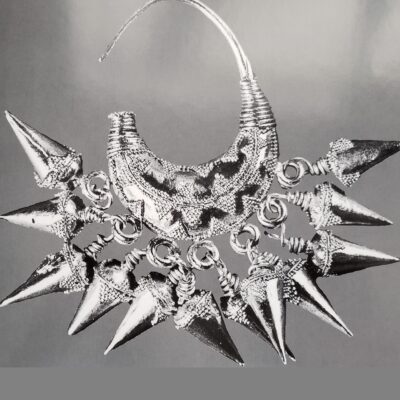
Fig (6 b)

Fig (7)
Anklets
Two pairs of solid gold hinged anklets were retrieved from Grave 2. One pair (figure 8) has six ribs each, and the other pair (figure 8), more simple, has five ribs soldered to a gold brackets. The ribs of the elaborate one are beads-like, while the ribs of the simple one are plain.
Bangles
A pair of golden bangles come from Grave 2 (figure 9). The bangles, to be worn around the forearms, are inlaid with onyx or glass alternating with golden bars. It is opened and closed by way of a pin that survived with the treasure.

Fig (8)

Fig (9) detail

Fig (9)
Cuffs
Two pairs of magnificent cuffs from Grave 2 are made of heavy gold and consist of a disk and a ring. They are inlaid with semi-precious stones protruding like large, bulging eyes. The disk (figure 10) is decorated with a round agate jewel placed in the centre; the jewel is surrounded with three circular bands, each formed with several inlaid rectangles separated by vertical bands. The space between the two largest bands is decorated with stars alternating with kneeling winged genii. This iconographic motif is also seen in a reconstructed wall painting from Sargon II’s citadel at Khorsabad (8th century). In both cases one can see groups of two genii facing each other on either side of a rosette or disk.
The edges of the ring are inlaid with semiprecious stones alternating with vertical gold bars. A row of inlaid tiger eyes are placed in the centre, surrounded by a frame of small rosettes.
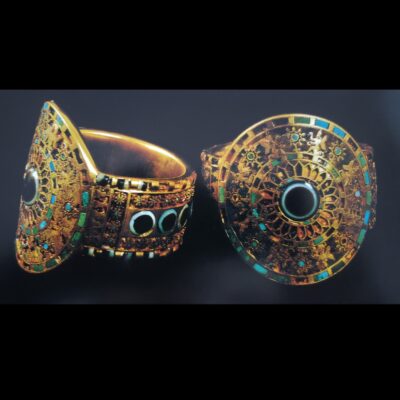
Fig (10)
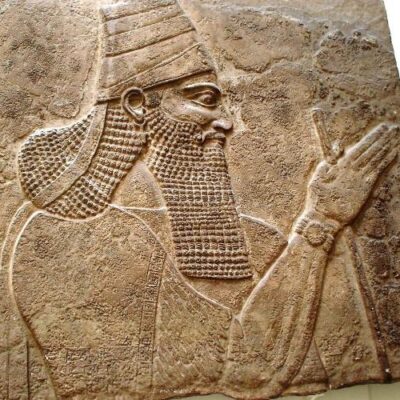
Assyrian relief
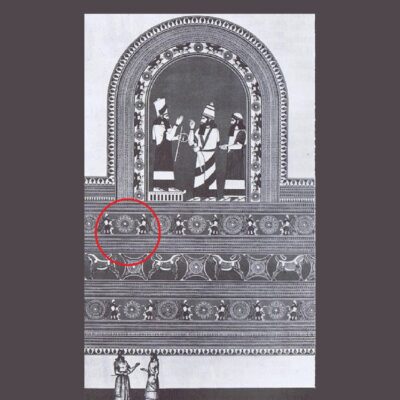
Assyrian relief
Tassels
The tassels are gold components of a crown made of flat surfaces decorated with Mesopotamian motifs, sitting against blue backgrounds (Figure 11, 12). Each of the two objects is decorated with gold beads on the top and with tassels at the bottom. The tassels consist of short chains each of which end with a pomegranate motif. One surface is decorated with a palm tree with the fruits seen hanging. Palm trees abound in Mesopotamia, hence the source of the motif. The surface of the other tassel is decorated with an Assyrian motif: a cultic tree seen from the 9th century BC downward to the end of the Assyrian civilizations. In figure 13 the tree is from the palace of King Ashurnasirpal II.
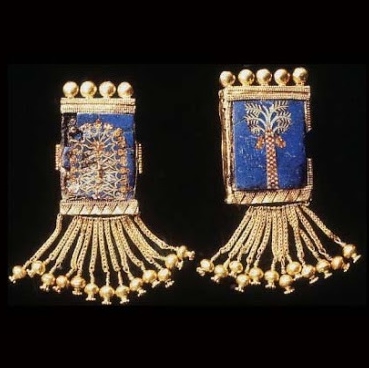
Fig (11)
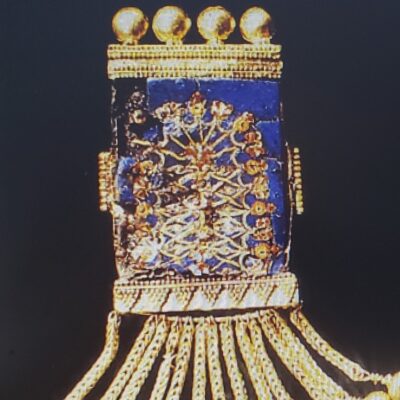
Fig (12)
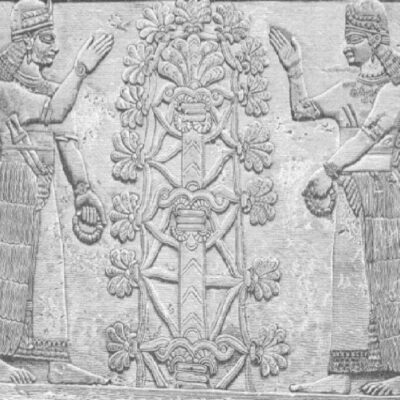
Fig (13) Assyrian relief
Headdresses
Grave 2 contains a splendid headdress, fascinating, intricate, and truly feminine. It is a royal headband (Figure 14,15) made of fine, woven, herringbone-patterned gold strands. It has six gold ribbons connected by hinges with five discs, each inlaid with a round jewel, in addition to a rectangular plaque decorated with rosettes around its edges. The plaque is inlaid with two square jewels, tassels are attached to its lower edge. The plaque, which represents the front of the headband, is attached to four gold ribbons, altogether forming a crown. From the back of the crown two other woven gold ribbons ending in tassels go down the neck and the back. The outline of the head-band resembles that of the Arabic ‘uqal which holds the kufiyya in place.
Another beautiful crown from Grave 2 (figure 16) consists of a round disk, 18 cm of diameter and 6 cm of height. It is decorated on the outside with 96 rosaces, a motif found in Assyrian palaces and wall paintings, as well as other buildings dated to the medieval period. The rosaces looks like chamomile flower seen in Upper Mesopotamia in spring. The simplicity of this crown, compared with the very elaborate one mentioned earlier does not undermine its beauty and its manufacture.
Other Jewels
There are other item, namely seals, pins and chains (figure 7), all of which highlight the diverse jewellery and the skills of the Assyrian goldsmiths who fabricated them with great success.
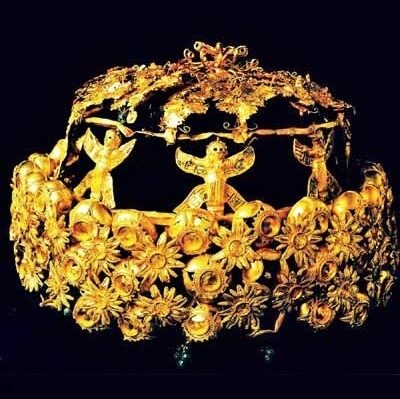
Fig (14)

Fig (15)

Fig (16)
Vessels
Magnificent vessels, including dishes, a jug, and a flask, were buried with the queens, to serving them in their ways to afterlife. The vessels bear motifs known to Assyrian art, a proof that they were made by Assyrian goldsmiths. Some bowls are inscribed in cuneiform with the names of Atalia, Yaba, Banitu, and Shamshi-ilu (Grave 3), and thus, the vessels are no doubt royal.
Jug
A highly decorated jug made entirely of gold is 13 cm high and derives from Grave 3 (figure 17,18). The top part is a cylinder, the rim of which protrudes slightly outward. The spout is quite large for the size of the jug, while the handle is S-shaped. The handle ends on the bottom sides with a leonine head and one the upper side with a serpentine head. As many as five bands decorate this jug, four of them represent hunting and battles. The sceneries are placed between bands made of scale shapes, and the same is true around the rim of the spout. The inside is covered with bitumen, just in case the gold is perforated during production.
Jugs are popular vessels and the general shape with neck, body, handle, and spout are found in every culture in antiquity and even today. The Assyrian jug is, however, unique in that it is made of gold, and its sceneries and the leonine and serpentine ends of the handle are all familiar in Assyrian art.
Bowls
As many as four bowls were found intact, buried with the queens. They were found in Grave 3, and the four are made of solid gold. The shape of the bowls is familiar since it is also found in the so-called Assyrian ‘Palace Ware’ pottery. For one of the vessels (figure 20) is not decorated and looks like real pottery attested at Nimrud. The pottery is characterized by having exceptionally thin walls, and some are less than one millimeter thin, indicating the attempt of the potter to imitate metal prototypes. These metal prototypes include bronze bowls of a semi-circular shape found by Henri Layard in Nineveh. The plain bowl in (figure 20) is the first such specimen made of gold hitherto discovered. A bowl of the same shape is attested in an Assyrian relief showing servants bringing vases to a banquet.
Another bowl (figure 22,23) is fluted and decorated with a rosace placed at the bottom in the centre. A famous relief of King Ashurbanipal and his wife sitting in the garden show the queen holding a vessel like this fluted bowel.
Let us also mention a bowl made of astonishingly clear crystal which has no parallel in antiquity. Remains of food for consumption in the next world are found in two alabaster jars placed in Grave 2. Several small, gold perfume bottles were also found, with two mirrors. The round mirrors are made of fine bronze, whereas the handles, which are in the shape of a palm tree inlaid with fine stone, are made of ivory. To complete the queen(s)’s make-up set, an ivory box and hair ornaments were placed in the coffin.
Flask
Grave 2 offered a gold flask (figure 19), measuring 13.5 cm in height. The elongated body is made of ribs and the top part is a narrow undecorated tube. Two rings at the top of the main body hold its chain. The small size of the flask must have contained perfume.
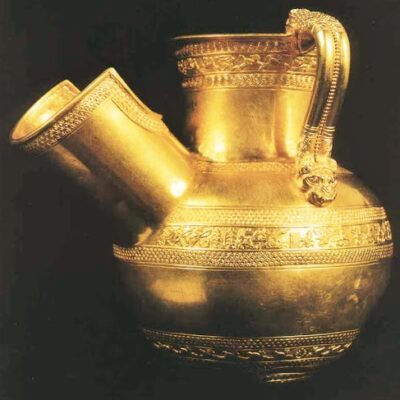
Fig (17)

Fig (18)
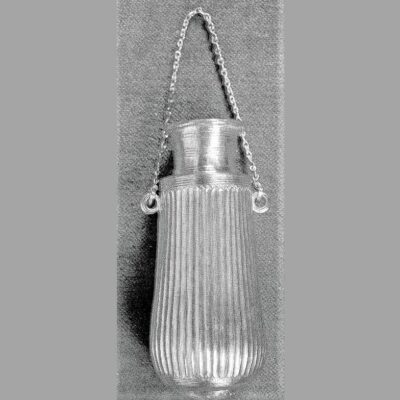
Fig (19)
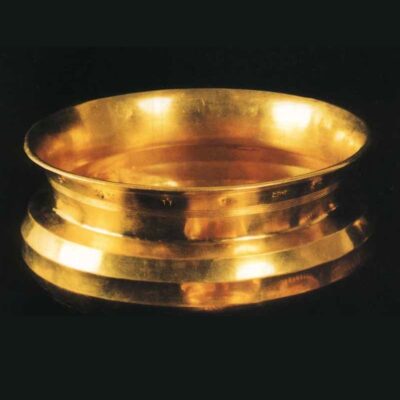
Fig (20)
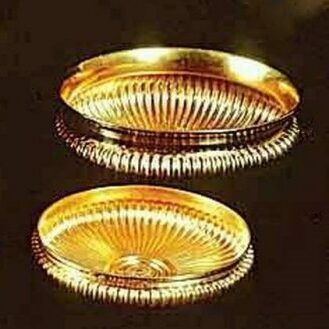
Fig (22)
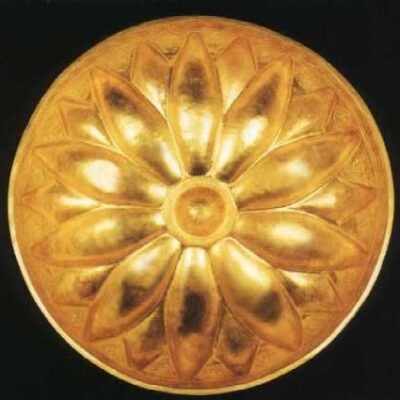
Fig (23)
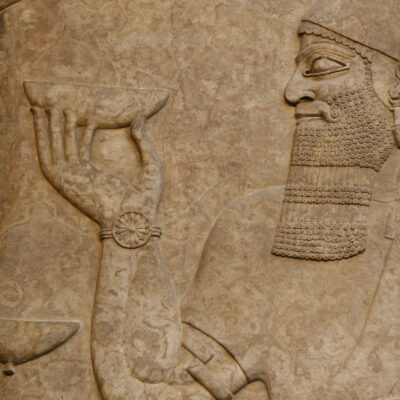
Assyrian relief
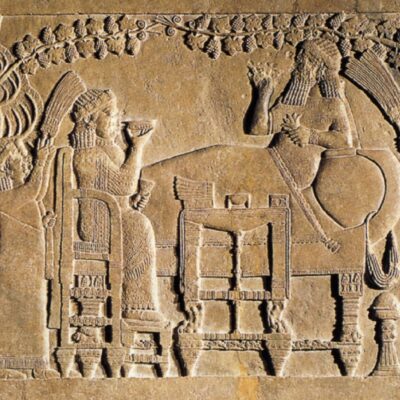
Assyrian relief
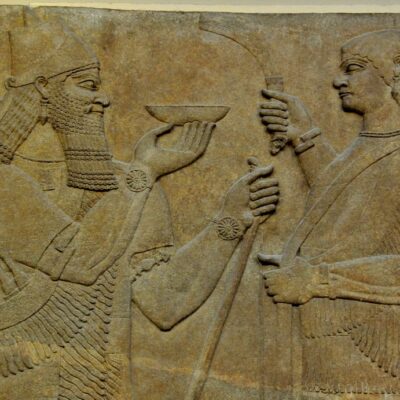
Assyrian relief
Final Remarks
The magnificent jewellery of Nimrud has revolutionized our knowledge of ancient technology, and gave us an idea about the Assyrian belief in life after death. The jewellery opens a new chapter on the surprising and admirable ability of the ancient goldsmiths to produce items that attract our admiration and appreciation. There is no reason to deny the Assyrian goldsmiths that ability, by thinking that the jewellery was booty of war. The many purely Assyrian and Mesopotamian motifs found on the jewellery indicate that it was manufactured in Assyria by native craftsmen.
Assyrian royal inscriptions mention royal exploits of kings, sometimes with details of violence and harshness, while propagandistic art depicts scenes sometimes dominated by cruelty. But this is one side of the Assyrian story. The other side is the finesse, artistic and imaginations of ordinary Assyrians, who worked as artists and goldsmiths. Combining both stories gives us a more complete idea about Assyrian civilizations.

Bibliography
Amir Harrak, “The Royal Tombs of Nimrud and their Jewellery,” Bulletin of the Canadian Society for Mesopotamian Studies 20 (1990) 5-13—largely quoted in the present article.
S. Damerji and Ahmed Kamil, Gräber Assyrischer Königinnen aus Nimrud (Mainz, 1999)—most pictures in the present articles are copied from this elegant book.
E. Curtis, H. McCall, D. Collon and L. al-Gailani Werr (editors), New Light on Nimrud: Proceedings of the Nimrud Conference 11th–13th March 2002 (London: British Institute for the Study of Iraq in association with The British Museum, 2008).
————————————————————————————————————————————————————————————————————————————————————————————————————
About Amir Harrak:
Amir Harrak is professor of Aramaic and Syriac at the University of Toronto. He has degrees in Art History, Linguistics, and Semitic languages and Literature. During his work at the Iraqi Museum on Syriac epigraphy between 1996 and 1999, he has seen the Assyrian jewellery and photographed them while exhibited in their glass cases.

